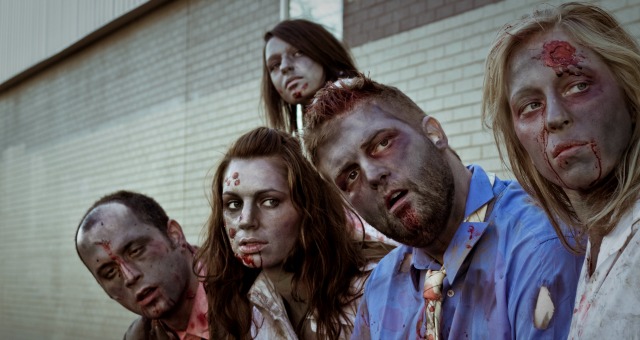College courses, like movies, can inspire, entertain, shock, or repulse. Instructors produce, direct, and star in a series of semester-long scenes, complete with audiences, critics, and awards. If your course could be equated to a movie genre, what would we be watching? Would we see a romantic comedy, focused on relationship-building and a predictable, subtle narrative? Perhaps it would be an action film – colorfully energetic, thrilling for some, and uncomfortable for others. Current research on learning suggests you may want to consider plot elements in zombie films as you design your courses. Here’s why.
- Hook. All zombie films begin with a dramatic attention-getter—an event that draws you in and demands you stay in your seat and watch every detail play out. Similarly, one study found that students who had an impactful, positive experience on the first day of class were more likely to have higher motivation throughout the semester and subsequently earn better grades in the course (Wilson & Wilson, 2007). For information about creating a great first day for your class, see The First Day of Class: A Once-a-Semester Opportunity.
- Collaboration. Simply put, characters in zombie films do better and are more likely do survive, when in groups. They are able to share workloads (like taking turns being the lookout and scavenging for resources), congregate skills and knowledge, and negotiate solutions in critical ways. Like the zombie movie characters, some research suggests that student motivation may be generated and facilitated by classroom collaboration (J"arvel"a, Volet, & J"arvenoja, 2010). For more information on structuring collaboration in face-to-face courses, see How to Improve Group Work: Perspectives from Students. For online courses, see Building Community and Creating Relevance in the Online Classroom.
- Problem Solving. Problem solving is the critical plot line in zombie films; characters must collaboratively deal with ill-defined, complex problems (e.g., protecting borders from zombie intrusions) and implement their solutions in order to endure. Research into Problem-Based Learning (PBL), one problem solving pedagogy, offers supportive evidence for practice; in fact, students may learn more through collaborative problem solving than through traditional lectures (Yadav et al., 2011). For more information on PBL, see Problem-Based Learning: Six Steps to Design, Implement, and Assess.
- Risk-Taking. Since problems in zombie films are ill-defined and do not have obvious best solutions, risk-taking is a necessity. Most zombie films have a character who holds out in taking a risk and wants to stay put, where it is “safe.” It almost never ends well for him or her. In academic contexts, risk-taking students are those who have the self-confidence to pursue creative endeavors and constructively deal with failure (Gibson, 2010). In doing so, instructors should encourage mastery goals (i.e., learning and improving without students taking big ‘hits’ to their grades when they try something new) rather than performance goals (e.g., grades and peer comparison). For more information on facilitating risk-taking, see Teaching Risk-Taking in the College Classroom.
- Humor. Traditional zombie films, like many horror films, do not simply scare the viewer – they entertain. They are a humorous, often satirical look at modern life. The humor keeps viewers invested in the humanity of the characters. Humor, when implemented appropriately in the classroom, may make instructors seem more likeable and approachable, and even contribute to greater content learning (Banas, Dunbar, & Liu, 2011). See Humor in the Classroom.
- Hope. Even with the previous five elements in place, successful characters in zombie films must maintain hope to be successful. Hope is a powerful contributor to learning and mental health; among new college students who may be at risk for psychological distress, hope contributes to their self-efficacy and academic success (Cranford, Eisenberg, & Serras, 2009). We can start developing students’ hope and self-efficacy by establishing a positive classroom community, providing appropriate learning feedback, and guiding students to understand the progress they have made. For help on instilling confidence and hope, see Finding Signs of Progress When Learning is Slow and Promoting Students’ Self-Efficacy in the Online Classroom.
Zombie films offer a framework for us to understand important elements of the learning process. Without each of these six elements, zombie film characters’ failure is inevitable. As we develop our courses, let’s use what we know from zombie film plots to write a script where our students have all the tools they need to successfully make it through the semester.
Resources
Banas, J. A., Dunbar, N., Rodriguez, D., & Liu, S. J. (2011). A review of humor in educational settings: Four decades of research. Communication Education, 60(1), 115-144.
Davidson, O. B., Feldman, D. B., & Margalit, M. (2012). A focused intervention for 1st-year college students: Promoting hope, sense of coherence, and self-efficacy. The Journal of Psychology, 146(3), 333-352.
Gibson, R. (2010). The ‘art’ of creative teaching: Implications for higher education. Teaching in Higher Education, 15(5), 607-613.
J"arvel"a, S., Volet, S., & J"arvenoja, H. (2010). Research on motivation in collaborative learning: Moving beyond the cognitive–situative divide and combining individual and social processes. Educational Psychologist, 45(1), 15-27.
Wilson, J. H., & Wilson, S. B. (2007). The first day of class affects student motivation: An experimental study. Teaching of Psychology, 34(4), 226-230.
Yadav, A., Subedi, D., Lundeberg, M. A., & Bunting, C. F. (2011). Problem‐based learning: Influence on students’ learning in an electrical engineering course. Journal of Engineering Education, 100(2), 253-280.
Vincent Genareo is an assistant professor of educational Psychology at Salisbury University.

